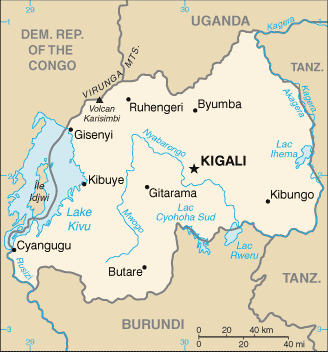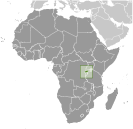
|
|
Advertisements:
People And SocietyNationality
Noun Rwandan(s)
Adjective Rwandan Ethnic groups
Hutu (Bantu) 84%, Tutsi (Hamitic) 15%, Twa (Pygmy) 1% Languages
Kinyarwanda (official, universal Bantu vernacular), French (official), English (official), Kiswahili (Swahili, used in commercial centers) Religions
Roman Catholic 56.5%, Protestant 26%, Adventist 11.1%, Muslim 4.6%, indigenous beliefs 0.1%, none 1.7% (2001) Population World Ranking: 73
11,689,696 (July 2012 est.)
Note Estimates for this country explicitly take into account the effects of excess mortality due to AIDS; this can result in lower life expectancy, higher infant mortality, higher death rates, lower population growth rates, and changes in the distribution of population by age and sex than would otherwise be expected Age structure
0-14 years
42.9% (male 2,454,924/female 2,418,504) 15-64 years 54.7% (male 3,097,956/female 3,123,910) 65 years and over 2.4% (male 110,218/female 164,913) (2011 est.) Median age
Total 18.8 years
Male 18.6 years Female 19.1 years (2012 est.) Population growth rate World Ranking: 18
2.751% (2012 est.)
Birth rate World Ranking: 24
36.14 births/1,000 population (2012 est.) Death rate World Ranking: 58
9.64 deaths/1,000 population (July 2012 est.) Net migration rate World Ranking: 54
1 migrant(s)/1,000 population (2012 est.) Urbanization
Urban population 19% of total population (2010)
Rate of urbanization 4.4% annual rate of change (2010-15 est.) Major cities - population
KIGALI (capital) 909,000 (2009) Sex ratio
At birth 1.03 male(s)/female
Under 15 years 1.02 male(s)/female 15-64 years 0.99 male(s)/female 65 years and over 0.67 male(s)/female Total population 0.99 male(s)/female (2011 est.) Maternal mortality rate World Ranking: 34
340 deaths/100,000 live births (2010) Infant mortality rate World Ranking: 25
Total 62.51 deaths/1,000 live births
Male 66.09 deaths/1,000 live births Female 58.83 deaths/1,000 live births (2012 est.) Life expectancy at birth World Ranking: 192
Total population 58.44 years
Male 56.96 years Female 59.96 years (2012 est.) Total fertility rate World Ranking: 25
4.81 children born/woman (2012 est.) Health expenditures World Ranking: 44
9% of GDP (2009)
Physicians density
0.024 physicians/1,000 population (2005) Hospital bed density
1.6 beds/1,000 population (2007) Hiv/aids - adult prevalence rate World Ranking: 25
2.9% (2009 est.)
Hiv/aids - people living with hiv/aids World Ranking: 31
170,000 (2009 est.)
Hiv/aids - deaths World Ranking: 43
4,100 (2009 est.)
Major infectious diseases
Degree of risk Very high
Food or waterborne diseases Bacterial diarrhea, hepatitis A, and typhoid fever Vectorborne disease MalariaAnimal contact disease Rabies (2009) Children under the age of 5 years underweight World Ranking: 41
18% (2005)
Education expenditures World Ranking: 98
4.1% of GDP (2008)
Literacy
Definition
Age 15 and over can read and write Total population 71.1%Male 74.8% Female 67.5% (2010 est.) School life expectancy (primary to tertiary education)
Total 11 years
Male 11 years Female 11 years (2009) People - note
Rwanda is the most densely populated country in Africa
Comments
Add a new comment: |
Advertisement
Members area
Rwanda (Kigali):
 
GPS points from Rwanda (Kigali)
|
||||||||

 In 1959, three years before independence from Belgium, the majority ethnic group, the Hutus, overthrew the ruling Tutsi king. Over the next several years, thousands of Tutsis were killed, and some 150,000 driven into exile in neighboring countries. The children of these exiles later formed a rebel group, the Rwandan Patriotic Front (RPF), and began a civil war in 1990. The war, along with several political and economic upheavals, exacerbated ethnic tensions, culminating in April 1994 in a state-orchestrated genocide, in which Rwandans killed up to a million of their fellow citizens, including approximately three-quarters of the Tutsi population. The genocide ended later that same year when the predominantly Tutsi RPF, operating out of Uganda and northern Rwanda, defeated the national army and Hutu militias, and established an RPF-led government of national unity. Approximately 2 million Hutu refugees - many fearing Tutsi retribution - fled to neighboring Burundi, Tanzania, Uganda, and Zaire. Since then, most of the refugees have returned to Rwanda, but several thousand remained in the neighboring Democratic Republic of the Congo (DRC, the former Zaire) and formed an extremist insurgency bent on retaking Rwanda, much as the RPF tried in 1990. Rwanda held its first local elections in 1999 and its first post-genocide presidential and legislative elections in 2003. Rwanda in 2009 staged a joint military operation with the Congolese Army in DRC to rout out the Hutu extremist insurgency there and Kigali and Kinshasa restored diplomatic relations. Rwanda also joined the Commonwealth in late 2009.
In 1959, three years before independence from Belgium, the majority ethnic group, the Hutus, overthrew the ruling Tutsi king. Over the next several years, thousands of Tutsis were killed, and some 150,000 driven into exile in neighboring countries. The children of these exiles later formed a rebel group, the Rwandan Patriotic Front (RPF), and began a civil war in 1990. The war, along with several political and economic upheavals, exacerbated ethnic tensions, culminating in April 1994 in a state-orchestrated genocide, in which Rwandans killed up to a million of their fellow citizens, including approximately three-quarters of the Tutsi population. The genocide ended later that same year when the predominantly Tutsi RPF, operating out of Uganda and northern Rwanda, defeated the national army and Hutu militias, and established an RPF-led government of national unity. Approximately 2 million Hutu refugees - many fearing Tutsi retribution - fled to neighboring Burundi, Tanzania, Uganda, and Zaire. Since then, most of the refugees have returned to Rwanda, but several thousand remained in the neighboring Democratic Republic of the Congo (DRC, the former Zaire) and formed an extremist insurgency bent on retaking Rwanda, much as the RPF tried in 1990. Rwanda held its first local elections in 1999 and its first post-genocide presidential and legislative elections in 2003. Rwanda in 2009 staged a joint military operation with the Congolese Army in DRC to rout out the Hutu extremist insurgency there and Kigali and Kinshasa restored diplomatic relations. Rwanda also joined the Commonwealth in late 2009.